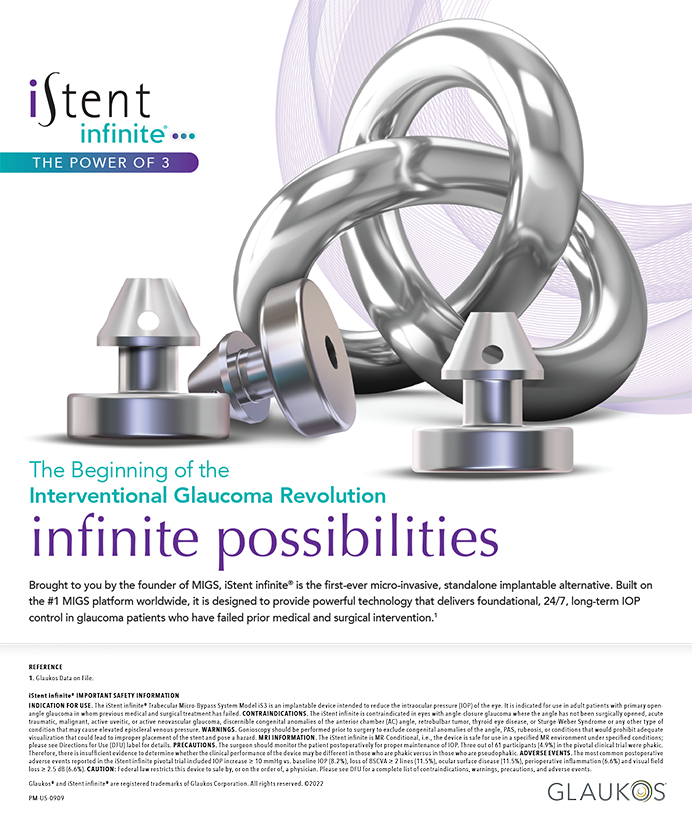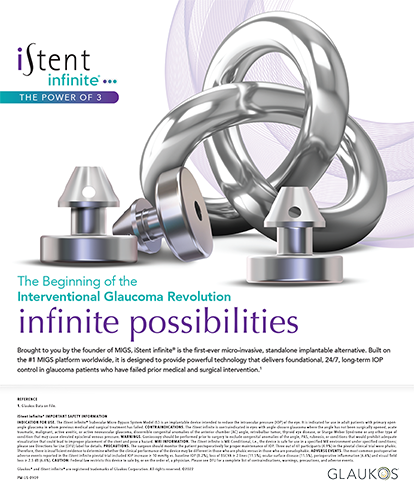The uveitic cataract patient deserves special attention, including careful preoperative management. Ophthalmologists must take into account potential peri- and postoperative challenges. The cataract may have developed due to the inflammatory disease, as in juvenile idiopathic arthritis, or secondary to treatment with corticosteroids. Although all types of cataract may occur in uveitic patients, the posterior subcapsular cataract is the most common presentation (Figure 1).1
ESTABLISHING THE DIAGNOSIS
Physicians can use the patient's medical history along with laboratory information to diagnose most types of uveitis.2 In general, the less inflammation present at the time of surgery, the better the overall clinical prognosis and the lower the possibility of severe postoperative complications.3 Determining the type, location (anterior and/or posterior), and cause of uveitis is important for anticipating the course of the disease, treatment response, and the rate of complications. For example, patients with uveitis secondary to juvenile idiopathic arthritis tend to have more postoperative inflammation than those with idiopathic etiologies.1,2 Ocular toxoplasmosis may be reactivated after cataract surgery, so pre- and postoperative treatment is recommended.4 Understanding the expected course of the inflammatory disease and level of control prior to cataract surgery will ultimately affect the timing of the procedure, perioperative medical management, and the decision whether or not to implant an IOL.
OPHTHALMIC EXAMINATION OF THE UVEITIC CATARACT
Overview
Generally, the goal of cataract surgery is successful visual rehabilitation. In the uveitic eye, the postoperative visual outcome depends on the surgery itself as well as preexisting damage from pre- and postoperative inflammation. A careful and complete ophthalmic examination spanning the anterior to posterior segments is critical for pre- and postoperative planning.
Slit-lamp Examination
Evidence of inflammatory sequelae on the corneal endothelium such as keratic precipitates (KP) facilitate the diagnosis of uveitis (eg, mutton-fat KP in sarcoidosis vs stellate KP in Fuchs heterochromic cyclitis [FHC]).3 The slit-lamp examination can also reveal multiple potential surgical complications. On the cornea, band keratopathy from chronic inflammation or scarring from prior herpetic disease may limit visualization. In some cases, it may be necessary to manage the corneal opacity by means such as chelation with calcium ethylenediaminetetraacetic acid after epithelial debridement to permit visualization.3
Pupillary Examination
A careful pupillary examination is critical to identifying poor dilation as well as posterior synechiae. A miotic pupil may necessitate the intraoperative use of iris hooks or pupil-expanding ring devices. Posterior synechiae may require gentle synechiolysis prior to cataract extraction to facilitate pupillary dilation and the surgeon's access to the anterior lens capsule (Figure 2).1-3
Patients with chronic uveitis may develop a cyclitic
membrane that extends from the ciliary body over the
back surface of the lens. The surgeon may need to excise
the membrane with scissors. Care must be taken when
pulling a cyclitic membrane, because ciliary body detachment
may result, leading to hypotony and phthisis.3
Vascularized membranes may also develop over the
entire pupillary surface. Some bleeding may occur during
removal, but these tissues and cells must be removed for
visualization.1-3 Finally, iris sphincter atrophy may occur
in patients with FHC, and it is considered a risk factor for
increased postoperative inflammation.1 The surgeon may
elect to perform a peribulbar or retrobulbar block if he or
she expects that manipulation of the iris will be extensive.
Gonioscopy
Frequently linked to uveitis, glaucoma can result from blockage of the angle structures or angle closure from peripheral anterior synechiae. Additionally, special consideration must be given to patients who are steroid responders. Although steroid use is often necessary, these agents may contribute to elevated IOP in this patient population.3 The glaucoma workup should include gonioscopy to evaluate the angle for anterior synechiae or angle vessels as in FHC.2 Vessels in the angle may result in a transient intra- and postoperative hemorrhage.5 Iris bombé can be treated with surgical peripheral (possibly sectoral) iridectomy, because persistent inflammation may compromise the patency of laser iridectomies. The indication for glaucoma surgery is the same as for any other glaucoma patient, but the postoperative course in uveitic eyes is more often complicated by scarring due to inflammation.3 The use of prostaglandin analogues should be avoided if possible to avoid provoking inflammation.
Dilated Fundus Examination and Ultrasonography
Physicians should perform a dilated fundus examination to identify posterior segment disease. In addition to glaucoma, the uveitic eye is prone to the development of cystoid macular edema, optic nerve disease, vasculitis, and neovascularization of the posterior pole. Because the presence of any of these conditions can limit the patient's postoperative visual potential, it is important to determine if the cataract or another simultaneous ocular pathology is causing the visual loss.1 Patients with Behçet syndrome, for example, often develop optic nerve damage or vasculitis, so cataract surgery is unlikely to improve their vision.3 If the surgeon's view of the fundus is limited (eg, in an eye with a dense cyclitic membrane), ultrasonography will help him or her to establish the degree of vitreous opacities as well as to confirm the presence or absence of a concomitant retinal detachment.2 If vitreous opacities are abundant, the surgeon may wish to perform a combined lensectomy and vitrectomy, because residual inflammation in the vitreous cavity can increase the frequency of uveitic recurrence.3
INDICATIONS FOR SURGERY
The decision to perform cataract surgery on a uveitic eye depends on the patient's visual disability, the degree of the cataract, and whether there is lensinduced inflammation. The ophthalmologist should proceed conservatively, and waiting for inflammation to subside is prudent. Unfortunately, lens-induced uveitis may necessitate more immediate cataract removal, even in the presence of active inflammation.
Cataract surgery in the uveitic patient thus falls into four clinical scenarios1,2,6:
• active inflammation due to the leakage of lens proteins,
as in phacoantigenic uveitis
• a visually significant cataract but well-controlled
uveitis and anticipated good visual recovery
• a cataract and limited view of the fundus, affecting
the evaluation and treatment of a possible fundus
disorder
• a cataract preventing visualization for posterior segment
surgery
In a quiet eye without active inflammation or sequelae from inflammation, cataract extraction does not pose a significant risk and often achieves a successful visual outcome, although careful postoperative control of inflammation is still critical. In lens-induced uveitis (phacolytic glaucoma, phacoantigenic uveitis, etc.), active inflammation can lead to poor outcomes intraoperatively and postoperatively. In phacolytic glaucoma, the lens is often fragile, and the capsule is easily ruptured. Due to the etiology of the uveitis, the lens must be removed in its entirety as soon as possible. Conversion to extracapsular cataract extraction may be necessary in these cases.3
CONCLUSION
Uveitic cataract patients require a thorough preoperative evaluation, control of inflammation, meticulous surgery, and careful postoperative management. With these steps, these individuals can undergo cataract extraction safely and successfully.
Richard E. Braunstein, MD, is the Miranda Wong Tang professor of clinical ophthalmology and chief of the Division of Anterior Segment at Columbia University in New York. Dr. Braunstein may be reached at (212) 305- 3015; reb10@columbia.edu.
Jennifer H. Hung, MD, is the cornea fellow and instructor in clinical ophthalmology at Columbia University in New York. Dr. Hung may be reached at (212) 305-3015; jhh120@columbia.edu.
- Foster CS, Rashid S. Management of coincident cataract and uveitis. Curr Opin Ophthalmol. 2003;14:1-6.
- Van Gelder RN, Leveque TK. Cataract surgery in the setting of uveitis. Curr Opin Ophthalmol. 2009;20:42-45.
- Smith RE, Nozak RA. Surgery in uveitis patients. In: Smith RE, Nozak RA, eds. Uveitis: a Clinical Approach to Diagnosis and Management. Baltimore, MD: Williams & Wilkins; 1989:115-126.
- Bosch-Driessen LH, Plaisier MB, Stilma JS, et al. Reactivations of ocular toxoplasmosis after cataract extraction. Ophthalmology. 2002;109(1):41-45.
- Bonfioli AA, Curi ALL, Orefice F. Fuchs' heterochromic cyclitis. Semin Ophthalmol. 2005;20:143-146.
- Okhravi N, Towler HMA, Lightman S. Cataract surgery in patients with uveitis. Eye. 2000;14:689-690.


